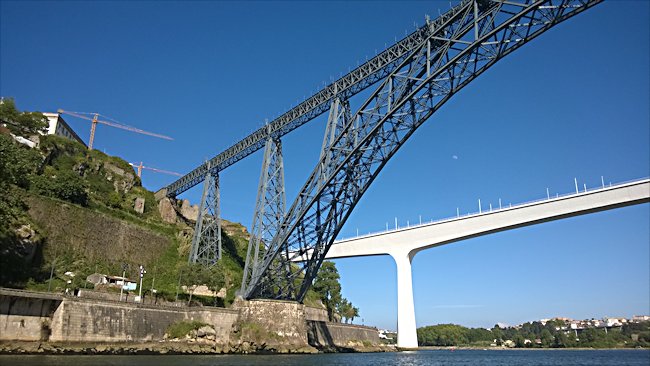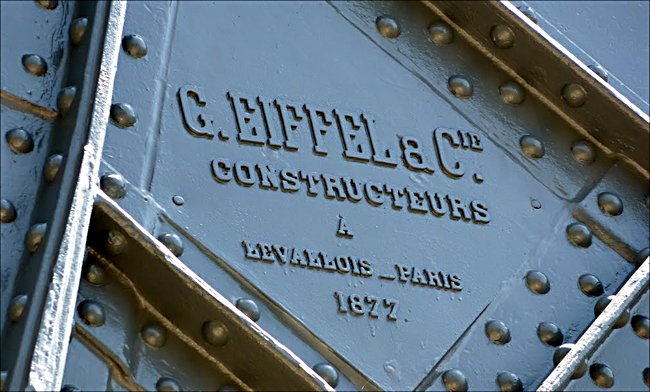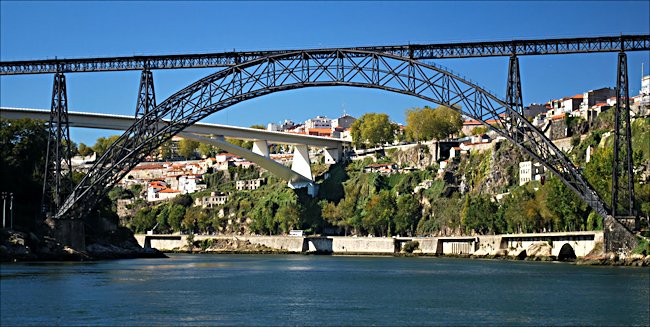Porto's Ponte Maria Pia Railway Bridge
The Maira Pia wrought iron bridge was a record breaker when it was constructed: in the way it was built simultaneously from both river banks and the length of the single arch span.

Porto's Maria Pia single span wrought iron railway bridge over the River Douro built by Gustave Eiffle
Who was Queen Maria Pia?
King Vittorio Emanuele was the first king of a united Italy. In 1862 his 15 year old daughter, Princess Maria Pia of Savoy, was married to King Luis of Portugal. Although extravagant in her tastes, she was liked by the people of Portugal because of all the charity work she was involved with. Her compassion for people of the lower classes resulted in her receiving the nicknames of "the Angel of charity" and "mother of the poor".
Her popular husband, King Luis, died 19 October 1889. Her son became king, and she became the Queen Dowager. She still continued her charitable work and was active in court. Tragedy came to her family at the end of her life stop: her brother, her son and her grandson were assassinated in Lisbon on 1 February 2008. The remaining grandson took the crown and became King Manuel II of Portugal. Two years later a military coup on 5 October 1910, declared Portugal a republic. The Royal family had to leave Portugal

G Eiffel and Company Constructeurs mark on the Ponte Maria Pia bridge
The French civil engineer Gustave Eiffel, now in his 40s, submitted a design to the Royal Portuguese railroad company, who were holding a competition to build a railway bridge over the River Douro. It was a difficult engineering problem to overcome. The River Douro valley near the city of Porto is practically a gorge, with high sloping sides. The river is deep and fast flowing.
The bed of the river was formed of layer upon layer of gravel. It was not stable enough to enable the construction of piers that could take the weight of the bridge. All plans submitted to the competition had to be of a bridge that could span 160 m (520 feet). The weight taking arch and the upright pillar had to start on the riverbank.
Gustave Eiffel, submitted a proposal for a railway bridge deck that supported by five iron up right piers. The arch, he had designed, was the longest arch span in the world at that time. One of the main reasons one the contract was that the price quoted to complete the work was a lot lower than his main Portuguese competitors.

This wrought iron railway bridge took the weight of a train using only one arch. It was revolutionary in the 1880s when it was built by Eiffel and Co
Construction started in January 1876. Eiffel's engineering company completed the bridge by the end of October 1877. King Luis I and the Queen Maria Pia attended the official ceremonial opening and naming ceremony of the bridge on the 4th November 1877.
Is the Ponte Maria Pia bridge used today?
The last scheduled railway service went over the bridge in 1991, having been in service for 114 years. Trains had become longer and heavier. Speed restrictions had to be implemented for travel across the bridge and there was a limit as to load weights. A more modern concrete bridge, called the St John's bridge, now takes the railway traffic from Lisbon to Porto. The future use of the bridge has not been decided. The bill for its maintenance is high and a decision will have to be made soon. Personally I think it should be made into a "Garden Bridge" like they have in New York and London. There could be a cafe in the middle. It could double up as a music event location. What do you think?
Travel Books


Tweet